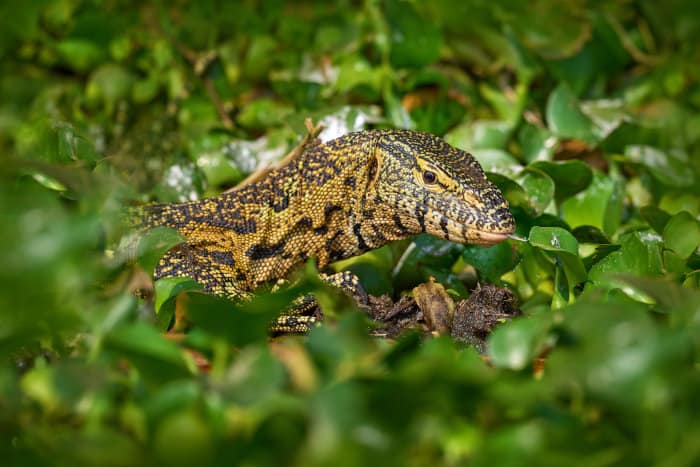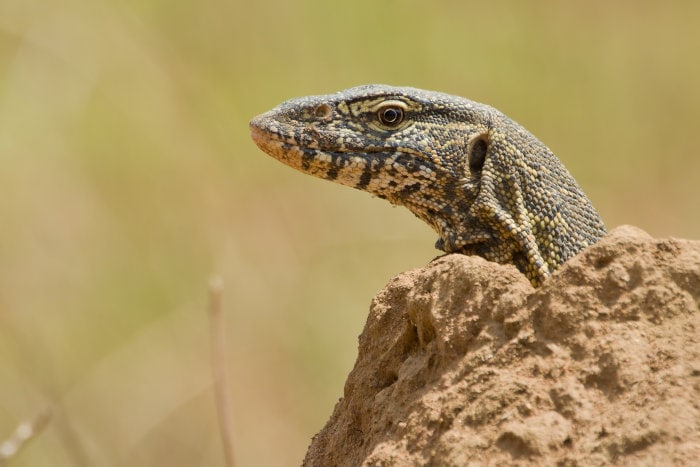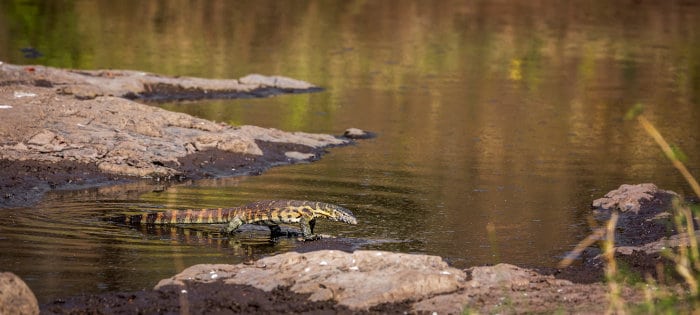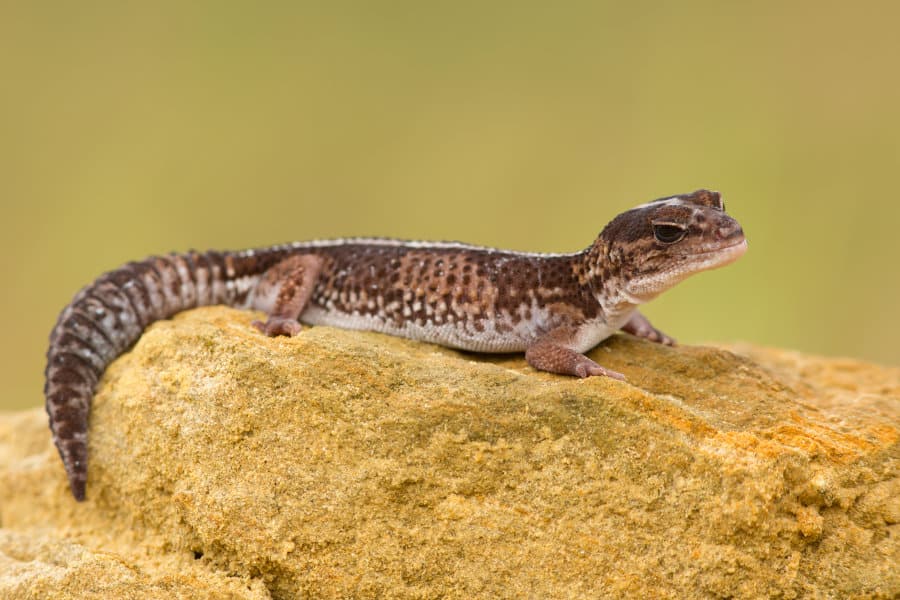Did you know there’s more than one giant reptile roaming the Nile River?
The Nile monitor may not be as fearsome as the crocodiles that patrol the same waterways, but Africa’s longest lizard is an impressive animal that can reach over two metres in length.
A strong swimmer, fast runner, and a voracious predator, the Nile monitor lizard lives throughout much of Africa, though it’s most at home in or around the water.
Well-adapted to its environment, this lengthy lizard boasts several adaptations including a long, flattened tail to aid swimming, and nostrils high on the snout to stay submerged for longer.
Want to learn more about Africa’s longest lizard?
Whether you’re a reptile lover or just curious about African animals, these 12 Nile monitor facts will shed some light on an interesting species.
1. It’s Africa’s Longest (and the World’s 4th Longest) Lizard

Nile monitors hold the title of ‘Africa’s longest lizard’. Only three Asian species measure more from head to tail.
Males are larger than females on average, with most between 1.5-1.7 metres long. Some stretch out to over two metres, while the largest reliably measured individual was a whopping 2.42 m.
Much of this is down to the monitor’s long tail, which can be 1.5 times the lizard’s body length.
Nile monitors might also be Africa’s largest lizards in terms of mass. Most weigh anywhere between 1-15 kg, while the largest tip the scales at 20 kg.
The rock monitor is the only other contender on the continent. It’s not as long, with a maximum length of just over two metres.
Some sources say average weight is heavier than the Nile monitor, although the largest males only reach around 17 kg.
2. Nile Monitor Appearance: Pretty Patterns and a Forked Tongue
Nile monitors are one of 80 species of monitor lizards in the genus Varanus. These lizards are known for being pursuit predators with powerful tails and claws.
The world’s largest lizard, the Komodo ‘dragon’, is also part of this group.
Nile monitor lizards, and all other monitors, also have a forked tongue like a snake, which they use to essentially ‘smell’ the air.
Rounding out the Nile monitor’s appearance are some striking scale patterns that vary by individual. Many are grey-brown or olive green in colour, with greenish-yellow barring and spots.
3. A Lizard of Many Names

The name ‘Nile monitor’ is descriptive enough, if a little misleading – they don’t just live in and around the Nile.
These lizards go by many other names, including African small-grain lizard, river leguaan, and water leguaan.
‘Leguaan’ is a South African word which stems from ‘iguana’ (a different group of lizards) but refers to monitors.
4. Nile Monitor Habitat: Riverside Reptiles
As the name suggests, Nile monitor lizards can be found along much of the Nile River. They range as far north as Egypt, though they’re absent from the rest of North Africa and the Sahara.
Nile monitors are also found throughout much of sub-Saharan Africa, avoiding desert regions but living in a variety of other habitats like woodland, wetland, and savanna, always near water.
5. They’re Strong Swimmers (and Climbers)

As you’d expect from a species so closely tied to the water, Nile monitors are excellent swimmers and spend a lot of time hunting in and around rivers and lakes.
Their long, powerful tail propels them through the water, and they can stay submerged for up to 15 minutes.
These multi-talented monitor lizards are also great climbers, scaling trees with ease.
6. How Fast is a Nile Monitor? Very!
Swimming skill aside, this rapid reptile is also speedy on land.
How fast is a Nile monitor lizard, exactly? It’s hard to tell, unless scientists get their stopwatches out for some more detailed studies.
Online sources differ, with figures ranging from 18 mph to 30 mph but little evidence in support of these numbers.
The perentie, an Australian monitor lizard of a similar size, has been clocked at 25 mph (40 kph) and is thought to be the fastest lizard in the world.
So, the truth might be somewhere in between the above figures. Either way, the Nile monitor could likely beat many humans in a foot race!
7. They Eat Crocodiles…

Well, sort of.
Nile monitors are carnivorous, and these ravenous reptiles prey on a variety of animals including other lizards, snakes, amphibians, rodents, fish, birds, invertebrates and more. Their teeth are quite blunt, but powerful enough to crunch down hard-shelled molluscs.
Nile monitors wouldn’t be silly enough to try and tackle an adult crocodile, but baby crocs and especially crocodile eggs are also on the menu. The lizards just have to ‘monitor’ their surroundings to make sure the vengeful parents aren’t coming back!
The sneaky lizards have even been known to cooperate in pairs, with one monitor distracting a mother crocodile and the other snatching some eggs.
8…But Crocodiles Also Eat Them
Nile monitors may be predators, but in the dog-eat-dog (or reptile-eat-reptile) world in which they live, they’re also prey for several species.
Crocodiles, snakes, and large raptors like the martial eagle will all prey on these lizards. Young monitors are also vulnerable to fish when swimming.
Nile monitors aren’t above a bit of cannibalism, either, with larger individuals sometimes snacking on their smaller brethren.
Making a meal out of this feisty lizard is no easy task. When threatened, Nile monitors can lash out with their powerful tail or use their claws. If all else fails, they release a foul-smelling substance to deter attackers.
9. Females Lay (a Lot of) Eggs in Termite Mounds

Nile monitor lizards can dig their own burrows or occupy those dug by other animals, although females will often choose an interesting place to lay their eggs: termite mounds.
In the rainy season, the female breaks into an active termite mound and lays her eggs. The termites then repair the mound, leaving the lizard’s eggs to incubate safely inside in warm, humid conditions.
Nile monitors lay the largest clutches of any lizard – up to 60 eggs. After incubating for nine months, the baby lizards hatch, waiting for rain to soften the termite mound and digging themselves out.
If the offspring can’t dig their way out, the mother might return to give them a helping hand, but after that, they’re on their own.
10. It Might Be Two Separate Species
Deciding what makes a separate species can sometimes stump scientists.
At present, the Nile monitor is considered one species (Varanus niloticus). Recently there’s been debate about whether the West African Nile monitor (Varanus niloticus stellatus) is distinct enough to be its own species: Varanus stellatus.
Genetic studies suggest the West African Nile monitor split off 7.7 million years ago – longer ago than humans and chimps diverged!
11. Nile Monitors Don’t Make Good Pets

With their attractive patterning, it’s not surprising some reptile lovers would want a Nile monitor as a pet.
Unlike some smaller and more docile African lizards, like the fat-tailed gecko, Nile monitors don’t do so well in captivity.
These lizards aren’t content to sit in a small tank – they need space and are highly active, not to mention aggressive.
With their powerful tails, claws and teeth, Nile monitors could even do some damage to their owners. Even tame individuals can bite or scratch when stressed.
In the wild, these lizards eat a varied diet, and they eat a lot. That means expensive food bills which will only increase as the animal ages.
Baby Nile monitors may look cute, but these large lizards can quickly outgrow their enclosures, leading many pet owners to abandon adult animals.
Overall, Nile monitors are only suitable for experienced and dedicated reptile owners.
12. Also Found in… Florida?
The Nile monitor’s natural range may be restricted to Africa, but some well-travelled specimens have made it to the USA.
Florida has become a hotspot for the Nile monitor, which is considered an invasive species in the United States.
The non-native lizard has established a population in many parts of the state, stemming from individuals either escaping from captivity, or being released.
Another risk of keeping unsuitable animals as pets.
See These Large Lizards on Safari

By far the best way to see Nile monitors is as nature intended, roaming in their natural African habitat.
Most people, lizard lovers aside, probably won’t go on safari specifically to see Nile monitors. Yet spotting Africa’s longest lizard in action can be a great experience.
If you’re looking to see these intriguing reptiles you’ve got a good chance. They’re widely distributed in most of the popular countries for African safaris and classified as ‘Least Concern’ on the IUCN Red List.
If you’re near the river, you’ve got a good chance of laying eyes on this lizard. Check out some of the best African safari countries and keep your eyes peeled for a slender silhouette gliding through the water.



